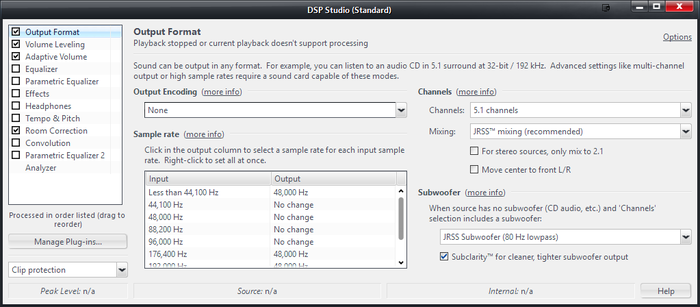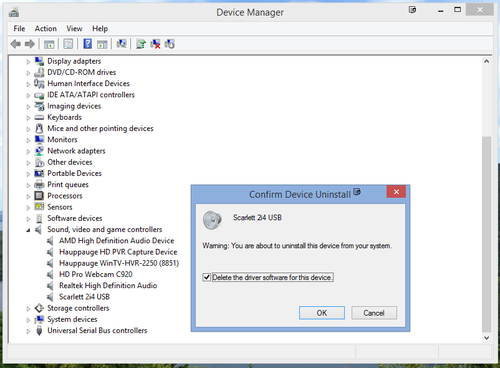Audio Troubleshooting Guide: Difference between revisions
(→Basics) |
(→Basics) |
||
| Line 17: | Line 17: | ||
* Is there an audio device installed on the computer? Check ''Device Manager'' to ensure there's an audio device and that it is enabled and working. |
* Is there an audio device installed on the computer? Check ''Device Manager'' to ensure there's an audio device and that it is enabled and working. |
||
* Is sound muted? Double click on the speaker icon in the lower right corner of the Windows desktop |
* Is sound muted? Double click on the speaker icon in the lower right corner of the Windows desktop |
||
* Try switching to Direct Sound [[Audio |
* Try switching to Direct Sound [[Audio Output Modes|Audio Output Mode]]. |
||
'''Poor Audio Quality:''' |
'''Poor Audio Quality:''' |
||
Revision as of 04:34, 8 April 2014
- further information: Media Center Troubleshooting Guide
A frequent cause of trouble is a misconfigured, or misbehaving, audio device. If you've messed with a bunch of settings in there, or you are using a more esoteric hardware setup, then you might just have to tweak something.
Troubleshooting Steps
- Work through the Audio Setup Guide
- Check on a few basics.
- Disable any DSP items you've enabled, to see if one of them is causing the issue.
- Check your Audio Device. If you can, try different audio outputs on the computer, to see if one in particular is having issues while others work.
- Make sure the amplifier or device at the other end (speakers, receiver, DAC, etc) is functioning properly, set to the right inputs, etc.
- Try another device using the same input on your receiver or speakers to ensure it isn't a problem with your amplification system.
Basics
No Sound:
- Is there an audio device installed on the computer? Check Device Manager to ensure there's an audio device and that it is enabled and working.
- Is sound muted? Double click on the speaker icon in the lower right corner of the Windows desktop
- Try switching to Direct Sound Audio Output Mode.
Poor Audio Quality:
- Try playing the track with an alternative media player. If you don't have a good option, VLC is cross platform and will play almost anything you throw at it.
- Trouble with Pops and Clicks?
File Ends Prematurely:
- Again, try the file(s) in another media player to ensure the problem is MC-specific
DSP Troubleshooting
If you determine the cause is caused by the DSP:
- Re-enable all of the DSP items you want to use.
- Disable them one at a time and try to recreate the issue.
Some DSP options require substantial computing horsepower, such as the Convolution Filter. You may find that your computer simply isn't powerful enough to accomplish what you're trying to do (at least with the types of sources you are using). However, it could be a simple misconfiguration. In particular, Output Encoding and Sample Rate settings under the Output Format DSP are a common cause of trouble. In most cases, the best quality will be achieved by leaving these at their defaults.
Checking for Misbehaving Audio Devices
If none of the above helps, or if you determine that the problem is related to a particular audio device, a good next step is to disable or physically disconnect any audio devices that might be misbehaving.
You may want to consider this particularly if you are getting crashes immediately when launching MC, or immediately upon playback of an audio file. Sometimes doing this through the Device Manager in Windows works, and sometimes it doesn't, and you must physically remove the device from the PC. With external devices, like USB DACs, unplug it from the PC and try the same thing using the PC's built-in audio.
In some cases, simply removing the device physically, and then booting Windows without the device installed will allow Windows to correct the driver issue. In many other cases, you may want to fully uninstall the device and all of its drivers and then start over from scratch.
To Uninstall the device driver from Windows fully:
- Go to the Uninstall Programs control panel, and remove all entries related to your audio device.
- Do not restart when prompted.
- Click Start and type: Device Manager
- Hit enter to open the Device Manager.
- Find the audio device in question under Sound, video and game controllers (be sure not to choose it via the Audio Inputs and Outputs part of Device Manager).
- Right click on the device and choose Uninstall.
- In the dialog that appears, check the Delete the driver software for this device option.
- Click OK to confirm.
- Shut down the PC and physically remove the offending device.
- Boot back up "cleanly" once.
- Obtain the latest version of the drivers for your device from the hardware manufacturer.
- Shut back down again, and then you can try reinstalling your audio device.
More
- Our Wiki topic, "Weird and Wonderful", has a long list of problems caused by other hardware and software.

